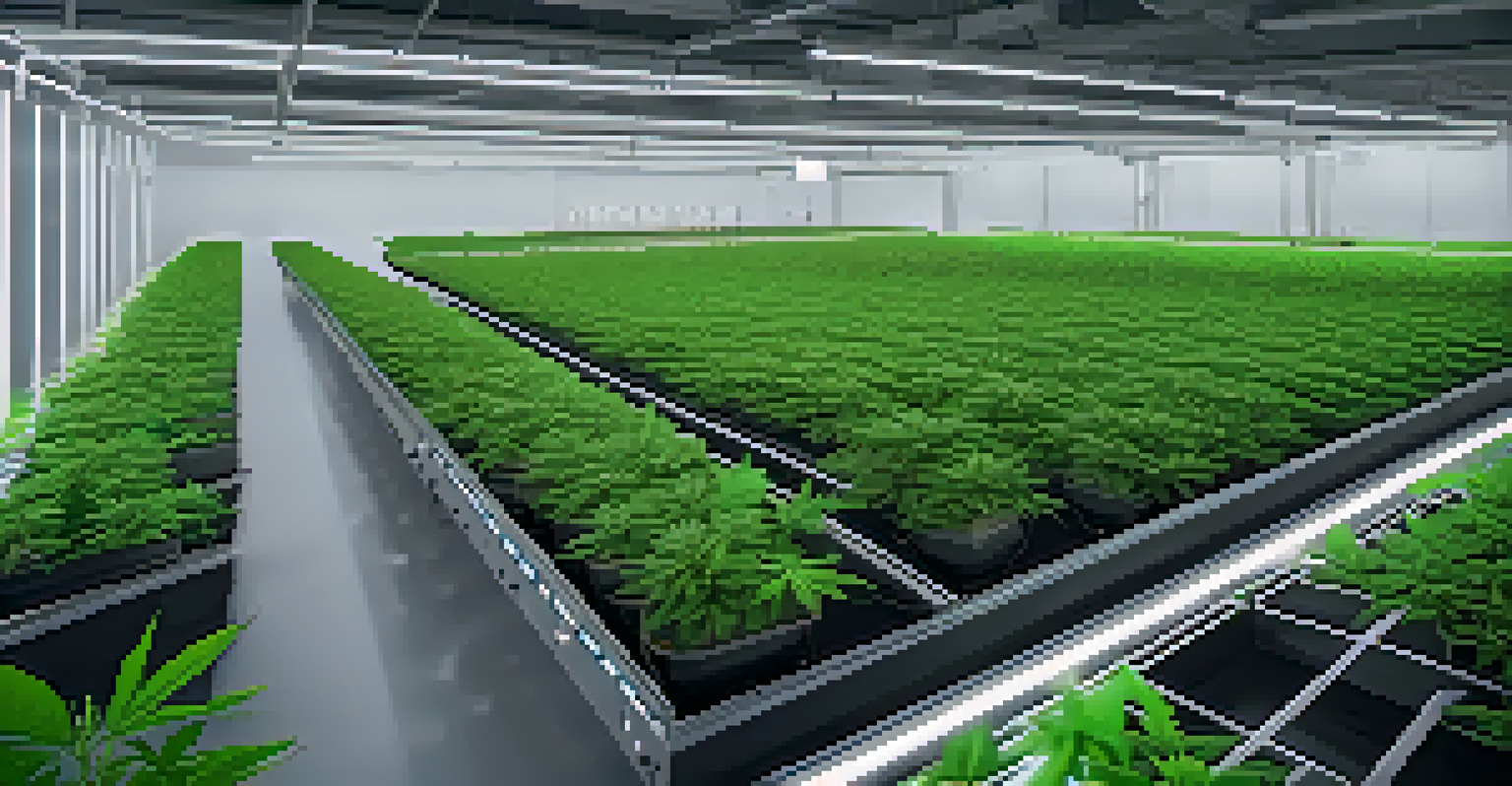Carbon Footprint of Marijuana Production and Mitigation Methods

What is a Carbon Footprint and Why It Matters
A carbon footprint measures the total greenhouse gas emissions caused directly or indirectly by an individual, organization, event, or product. Understanding this concept is crucial because it helps us assess our impact on climate change. For instance, everyday activities like driving a car or using electricity contribute to this footprint.
The greatest threat to our planet is the belief that someone else will save it.
In the context of marijuana production, the carbon footprint can be substantial, largely due to energy-intensive practices. Indoor cultivation, which is common in many regions, often requires significant electricity for lighting, heating, and ventilation. Thus, the carbon emissions associated with this process can be quite high.
Recognizing the carbon footprint of marijuana production is essential for growers and consumers alike. By being aware of this impact, we can make informed choices that not only benefit our health but also the health of our planet.
The Environmental Impact of Marijuana Cultivation
Marijuana cultivation, especially when done on a large scale, can lead to various environmental challenges. The use of pesticides, excessive water consumption, and land degradation are just a few concerns. For example, the demand for water in certain regions can strain local supplies, affecting other agricultural activities.

Additionally, outdoor grows can disrupt local ecosystems, leading to habitat loss for wildlife. The chemicals used in cultivation can seep into soil and waterways, impacting biodiversity. This environmental disruption highlights the need for sustainable practices in the industry.
Understanding Carbon Footprint
A carbon footprint measures greenhouse gas emissions from activities like marijuana cultivation, highlighting its environmental impact.
Overall, the environmental impact of marijuana cultivation cannot be overlooked. As the industry continues to grow, finding ways to mitigate these effects becomes increasingly important for both producers and consumers.
Energy Consumption in Indoor Marijuana Growing
Indoor marijuana growing is known for its high energy consumption, primarily due to the need for artificial lighting and climate control. According to some studies, a single indoor cannabis plant can consume as much energy as a household over a month. This energy demand contributes significantly to the carbon footprint of marijuana production.
We won't have a society if we destroy the environment.
In many cases, growers use high-intensity discharge (HID) lights, which, while effective, are not energy-efficient. Transitioning to LED lights can reduce energy consumption and lower overall emissions. However, the initial investment might deter some growers from making the switch.
Addressing energy consumption in indoor marijuana growing is vital for reducing its carbon footprint. By adopting more sustainable practices, the industry can minimize its environmental impact while still meeting consumer demand.
Water Usage in Marijuana Cultivation
Water usage is another critical factor in the carbon footprint of marijuana production. Growing cannabis, especially in large quantities, can require substantial water resources. This demand can lead to over-extraction of local water supplies, impacting both the environment and nearby communities.
For instance, in arid regions where water is scarce, the cultivation of marijuana can exacerbate existing water shortages. Sustainable water management practices, such as rainwater harvesting and drip irrigation, can help mitigate this issue. These methods not only conserve water but also reduce the overall environmental impact.
Sustainable Cultivation Practices
Adopting energy-efficient technologies and organic farming can significantly reduce the carbon footprint of marijuana production.
Ultimately, responsible water usage in marijuana cultivation is essential for sustainability. By prioritizing efficient practices, growers can help protect vital water resources, making the industry more environmentally friendly.
Carbon Emissions from Transportation in Marijuana Supply Chain
Transportation plays a significant role in the carbon footprint of marijuana, from farm to consumer. Whether it's delivering products to dispensaries or transporting them to consumers, each step involves emissions. The geographical distance traveled can greatly influence the total carbon output associated with marijuana products.
For example, if marijuana is grown in one state and transported to another, the emissions from trucking can be substantial. This scenario is common in regions where legal restrictions limit local cultivation. Finding ways to reduce transportation emissions is crucial for lowering the overall carbon footprint.
By supporting local growers and reducing transportation distances, consumers can help minimize the carbon impact of marijuana products. This shift not only benefits the environment but also fosters community support and economic growth.
Mitigation Methods for Reducing Carbon Footprint
There are several effective mitigation methods that producers can adopt to reduce the carbon footprint of marijuana cultivation. One approach is implementing energy-efficient technologies, such as LED lighting and smart climate control systems. These innovations can significantly lower energy consumption and associated emissions.
Additionally, organic farming practices can help minimize the use of harmful pesticides and fertilizers, thereby reducing environmental damage. By focusing on sustainable cultivation methods, growers can promote healthier plants and a cleaner environment.
Consumer Choices Matter
Consumers can influence sustainability in the marijuana industry by supporting eco-friendly growers and making informed purchasing decisions.
Ultimately, the adoption of these mitigation methods is essential for a sustainable marijuana industry. By prioritizing eco-friendly practices, producers can help ensure that their operations contribute positively to the environment.
Consumer Choices and Their Impact on Sustainability
Consumers play a vital role in shaping the sustainability of the marijuana industry through their choices. By opting for products from eco-friendly growers, consumers can support practices that prioritize environmental health. This support can encourage more producers to adopt sustainable methods.
Moreover, being informed about the carbon footprint of different marijuana products can help consumers make better choices. For instance, choosing locally sourced products can significantly reduce transportation emissions. This awareness can lead to a more conscious consumer base that values sustainability.

In conclusion, consumers have the power to influence the marijuana industry towards more sustainable practices. By making informed choices, they can contribute to reducing the overall carbon footprint and promote a healthier planet.
The Future of Sustainable Marijuana Production
The future of marijuana production hinges on sustainability and reducing the carbon footprint associated with cultivation. As awareness of environmental issues grows, both consumers and producers are increasingly prioritizing eco-friendly practices. This shift could lead to innovations that make marijuana cultivation more sustainable.
For instance, advancements in agricultural technology may result in more efficient growing methods, reducing water and energy consumption. Furthermore, the push for organic and local products could reshape the industry, leading to a more environmentally conscious approach to marijuana cultivation.
Ultimately, the path towards sustainable marijuana production involves collaboration between growers, consumers, and policymakers. By working together, we can foster an industry that not only meets demand but also respects and protects our planet.